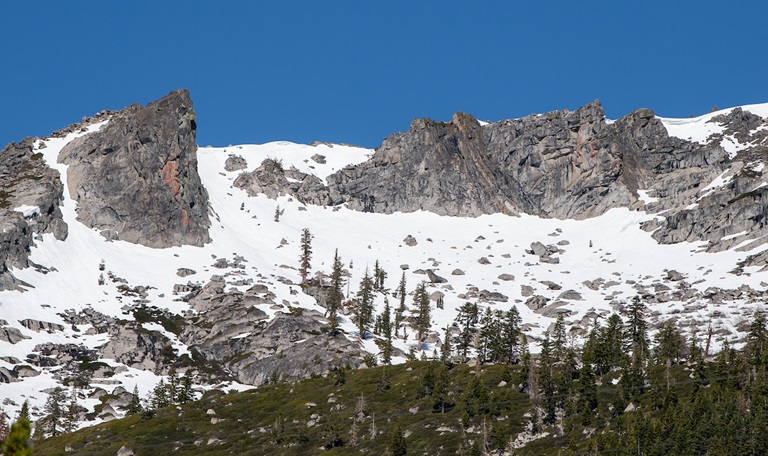How DWR Research is Improving Forecasting for California's Variable Climate
Mountainside still holds on to snow near Phillips Station in the Sierra Nevada Mountains, the site of the DWR final snow survey of the 2020 season. Photo taken April 30, 2020. DWR/2020
California has the most variable weather conditions in the United States, often varying between extremes such as drought and flood. Our ability to forecast variable weather conditions well in advance is a driving factor in how water managers maximize the benefits and minimize the hazards of each storm.
California’s climate, and how it is changing
Precipitation variability in California is due to our Mediterranean climate, characterized by long, dry summers and mild, rainy winters. Typically, we rely on five to seven significant storms for the bulk of our annual precipitation.
On average, California receives about 200 million acre-feet of water per year in the form of rain and snow. However, we rarely experience an average year. Instead, California’s snowpack has been alternating between extreme wet and dry years. Over the last decade we’ve seen three of our smallest snowpacks on record --and three of our largest snowpacks.
Increased temperatures lead to precipitation that falls as rain instead of snow, which increases the frequency of winter floods. Additionally, rain results in immediate runoff into reservoirs, requiring reservoir operators to increase releases to maintain flood control space. In cold years, precipitation is stored in solid form as snow, which slowly melts in the spring and summer months for water supply, agriculture, recreation, power generation, and more.
“The narrative around climate change describes warming temperatures leading to increasing variability and extremes in precipitation, and a transition toward more rain and less snow,” said DWR’s State Climatologist Dr. Michael Anderson. “The past decade is an indication of how this expectation is now becoming a reality.”
Atmospheric rivers account for 40 to 60 percent of California’s annual precipitation. As climate change continues to warm the atmosphere, the variability in number, strength, and duration of these storms is expected to increase. This means that it might be possible to have fewer atmospheric rivers, indicative of a dry year outcome, but have one of these storms be large enough to cause flooding.
The long-term sustainability and reliability of water in California requires that we all work together to find solutions, using the best science and technology available in forecasting.
Research into Forecasting
As variable climate conditions increase in frequency, DWR is working with state, federal, and academic research partners to improve our capabilities to monitor, forecast, and respond to impacts from climate change.
DWR started investing in improving our abilities to monitor and forecast the impacts of climate change in 2007. These investments included tools that make use of our growing knowledge of atmospheric rivers and their impact on California’s water resources.
Adding to existing federal funding in these areas, DWR has invested approximately $40 million in the past 13 years, enabling greater outcomes through collaboration.
One example of DWR’s investment into emerging technologies is using Light Detection and Ranging (LIDAR) – a detection system using light from a laser – to provide detailed spatial information about the ground surface and vegetation. This technology is used in remote areas normally inaccessible to manual snow surveys; having access to this data improves our snow melt and water supply forecasting abilities.
In partnership with DWR, researchers from the Desert Research Institute (DRI) developed new technology to interpret data collected from the ground, unmanned and human-piloted aircraft, and satellites about our atmosphere, rainfall, snowpack, rivers, and vegetation.
“Both satellites and aircraft provide information about atmospheric conditions that we would otherwise be unable to observe,” said Dr. Benjamin Hatchett with DRI. “Satellites give us a global perspective and local picture that is important for understanding how the landscape will respond to a storm event or how it has been responding to past conditions. This information is also extremely important for weather forecast models to ensure high quality forecasts are produced by using the most up-to-date conditions of the Earth system.”
DWR utilizes technologies developed by DRI and other partners to improve forecasting and better understand climate change and variability.
The Department’s Forecast-Informed Reservoir Operations (FIRO) program is one example of how these emerging technologies are used to improve the forecasting of runoff into reservoirs and to better coordinate flood releases made from those reservoirs. These technologies give reservoir operators advance insight into the size and strength of incoming weather systems, and through FIRO, the ability to release water days before a storm impacts a region. This creates needed space in the reservoir to accommodate the runoff from an incoming storm, therefore limiting potential impacts to downstream communities.
Adapting to a changing climate for water management and emergency response will require improvements in our understanding of extreme and variable conditions. DWR’s investments the past 10 years are just the start of enabling our staff to be more effective in responding to our changing climate. But continued investment is needed to transition from pilot efforts to full deployment to prepare California for what comes next.
